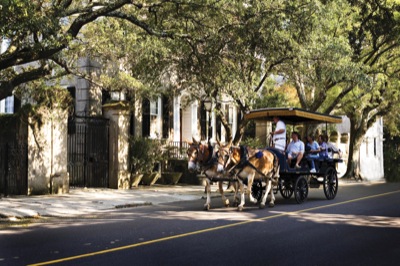
Courtesy Charleston Area CVB
Another authentic Charleston experience is to visit one of the city’s historic houses.
“Go into one of the house museums,” said Mellen. “It is like going back in time to early-19th-century America. It is one of the few places in the country that has as much concentrated in such a small area.”
Despite heavy Union bombardment during the Civil War and a massive earthquake in 1886, many 18th- and 19th-century houses survive and are a veritable museum of architectural styles, among them Colonial, Georgian, Federal, Classical Revival, Gothic Revival, Italianate and Victorian.
A few blocks north of City Market, across Meeting Street from the Charleston Visitors Center and next door to the Charleston Museum, is the Joseph Manigault House. Operated by the museum, the 1803 house is filled with American, English and French furniture from the period that depicts the lifestyle of a wealthy rice-planting family.
In the same block, the Aiken-Rhett House, originally built in 1818 and greatly expanded in the 1830s, is a good example of antebellum life in the city.
Charleston proper sits on a peninsula between the Ashley and Cooper rivers, which come together in Charleston Harbor or, as some locals sometimes claim, “come together to form the Atlantic Ocean.”
A must-see is the Battery, located along the southern tip of the peninsula, with the Waterfront Gardens, views of the harbor and a concentration of historic houses.
The 1825 Edmondston-Alston House is the only house on the Battery open for public tours, but many of the private houses are well worth walking past. The owners still live on the third floor of the Edmondston-Alston House, whose furnishings are 90 percent original to the house. The tour ends on the piazza, or front porch, with sweeping views of the harbor.
Within easy walking distance are three other historic homes open for tours: the 24,000-square-foot Italianate Calhoun Mansion, the largest with 35 rooms; the Heyward-Washington House, known for its ornamental woodwork (and yes, George Washington did sleep there during his 1791 presidential visit); and the Nathaniel Russell House, a national historic landmark built in 1808, famous for its freestanding “flying” spiral staircase.
While walking, or while riding in a horse-drawn carriage, be on the lookout for Rainbow Row, the much-photographed line of restored, mostly 18th-century mansions facing the Cooper River on East Bay Street that are painted a colorful — and historically accurate — palette of pastel colors.
Strolling Charleston’s narrow, twisting and sometimes cobblestone streets also provides an opportunity to check out the small gardens behind many houses that are filled with an array of flowers and carefully designed details.
“If you are walking down the street, you can peek into the gardens,” said Mellen. “Charlestonians are avid gardeners. It is a gardening paradise; nearly anything grows in Charleston.”
Although, traditionally, an open garden gate is an invitation to step inside, Mellen recommends taking a guided tour where arrangements can be made ahead of time for a garden visit.
After returning to their motorcoaches, groups will want to head up the peninsula to visit some of the outlying plantations.
“I recommend visiting one of the plantations where all of the wealth came from rice, indigo and, later, cotton,” said Mellen. “It is so important to know the background and history of why this area is so important.”










